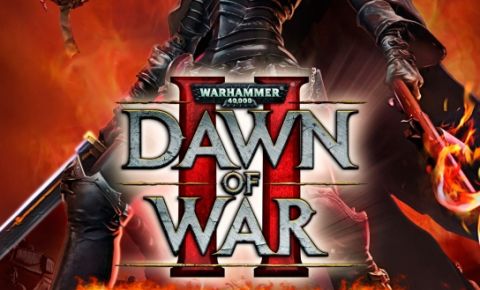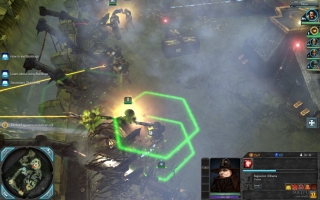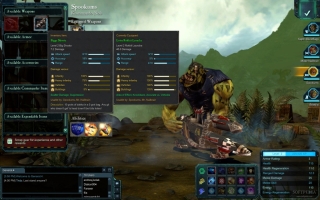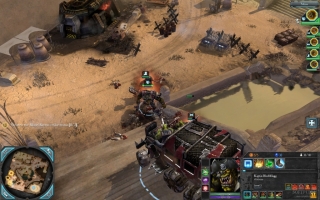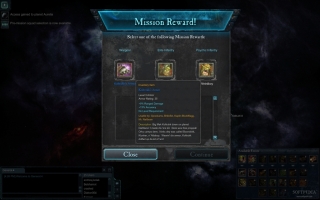If there's one race that always feels like it’s getting the worst of the Warhammer 40,000 universe, it's the Imperial Guard. There are a lot of them but most are badly trained, ready to flee at the first sight of xenos and easy prey for all manners of enemies of the Imperium.
Dawn of War II managed to erase some of the shame of being a virtual part of the Imperial Guard, creating a game faction that manages to feel fragile while also being more than able to stand toe to toe in terms of firepower with the hard-hitting Space Marines, the quick Eldar, the powerful Chaos, the rather crazy Orks and the numerous Tyranids.
Dawn of War II – Retribution is the second expansion for real time strategy game and Relic has really gone big on this one, similarly to what they have done in the Dark Crusade expansion for the first game in the year.
There are six races to play around with and Relic also made a number of other changes to the campaign side of the game, most of them good for the game but, unfortunately, overshadowed by the limited variety of the maps offered.
Story
Dawn of War II was initially seen as a step back for the series because it tasked gamers who loved the Warhammer 40,000 to only focus on the Space Marines, the genetically modified forces loyal to the Emperor, with other races only coming out just as enemies. Chaos Rising did the same thing, but this time allowing for a bit of evil to touch the earnest heroes.
Now Relic is going all out, allowing players to play six campaigns with six races. Yes, most of the missions in there are the same, regardless of which race one chooses and the first two ones especially are a bit of a pain to play through again, but they are tackled in wildly different manner depending on the faction choices the player makes.
The Space Marines are tactical and sturdy, the Imperial Guard are cannon fodder with artillery, the Eldar are glass cannons with abilities, the Orks can be actually funny and suicidal, Chaos is Space Marines with stirred-in evil while the Tyranids play like the Zerg on steroids.
The six different campaigns mean that developer Relic has not managed to craft the same over-the-top, yet totally serious dialog for all the races, and I developed much less of a connection to the heroes seen in Retribution than to the ones I guided in Chaos Rising and the original campaign.
The best way to enjoy the single player and the narrative is to play through one campaign, then get into some multiplayer or some Last Stand and then keep back for another campaign until all of them are done.
Gameplay
Retribution is all about variety and possibilities. It's about deciding whether you want heroes or Honor Guard units, about choosing between advancement paths in the star map, and about how to spend resources and population points on the tactical maps.
The big and very real criticism that can be leveled at Retribution is that, in the campaign mode, the missions and maps are the exact same regardless of what race you choose. This means that the story is sometimes stretched to the breaking point, but the big issue is that a lot of players will go through it once, using their favorite race, and will then abandon the single player in order to focus on Last Stand or on more standard multiplayer battles.
That would be a shame considering how different the campaign can be depending on the faction chosen and on the play style that a player adopts. The Ork campaign, for example, is hilarious and focuses on the incredible insanity that the race can deploy, with heroes that focus on explosions and quick brutal assaults, while the Space Marine set-up I used initially is all about hero survivability and about adaptability, always ready to bring the right weapon for the fight.
But I could play a more reckless Space Marine campaign and could bring some order to the Orks by choosing other upgrades for the heroes or by ditching them entirely and using the Honor Squads, which get bonuses themselves and can be supported by bigger numbers of normal units, taken pretty much out straight from the multiplayer mode.
Another disappointment is that the maps are pretty much corridors and allow for little of the flexibility that existed in the initial campaign. It would have been a better idea for Relic to create a more limited number of maps but focus on making them as open as possible, with a variety of drop in points, a lot of places for possible objectives and plenty od space for players to engage in open ended battle sequences.
Retribution is a good game and there's a lot of variety here for the fans that love the Warhammer 40,000 universe, but it could have been great if a little more attention was paid to the map design.
The entire campaign is playable in cooperative mode with another buddy, and this time around the fact that normal units can join in the battle means that each of the players has more to do than in the original game or than in Chaos Rising.
Graphics and audio
Retribution looks good, especially when zoomed out as much as possible in order to direct tactical movements, but the Dawn of War II engine is beginning to show its age in certain sections, especially in the cutscenes that are generated using it. The good news is that the game does not slow down significantly even in the biggest multiplayer matches, especially when players take care to choose setting that their hardware can support.
The voice work is also adequate although limited in narrative scope by the fact that there are six races to play around with. A special mention goes out to those who worked on the Ork, which now mix their usual borderline incomprehensible dialect with a pirate theme.
Multiplayer
Despite the original Dawn of War II arriving in February 2009 and the expansion coming roughly one year later, the game has retained a pretty dedicated crowd of gamers who come back regularly for the multiplayer experience that it offers.
And the launch of Retribution will surely see even more old hands come back and try their hand at the new Imperial Guard faction and master the new commanders and their abilities.
Each faction gets a new unit for Retribution and they all seem like nice little squads to play around with, although I doubt any one of them will become fundamental elements in a winning strategy any time soon.
The Imperial Guard is all new and surprisingly balanced, given that they are often portrayed as being the weaklings of the Warhammer 40,000 universe, squishy simple humans that are often no more than speed bumps in the advance of the enemies of mankind and are often destroyed by the Space Marines, the force that comes close to actually sharing their goals.
The key to playing them well seems to be in getting Ogryns as quickly as possible, using them to absorb damage from the most powerful enemy units and attract their attention while applying superior firepower via tanks (the missile launcher is especially well suited) or via massed guardsmen squads with as many officers included as possible.
The Last Stand mode also received an update, with a new map for players to test their skills on and an Imperial Guard hero added in the person of Castor, with quite a few skills that mostly lead to a crowd control role. At the moment, there are quite a few newcomers trying it out and the matchmaking system seems to be having a bit of a problem with finding good teams of three for more season Last Stand gamers.
Retribution also ditches the Games of Windows layer for matchmaking and uses the internal Steam service, which is easier to deal with, but at the moment some players have reported trouble with getting their multiplayer statistics imported into the new release.
The multiplayer is good and the Imperial Guard makes a good, balanced addition and the new Last Stand map is challenging and a pleasure to play, and these two bits alone mention the price tag. For those who only play the campaign, my advice is to wait up and pick Retribution out when THQ and Relic put out the inevitable Dawn of War II Complete Collection. All others can pick up Retribution now, play one campaign, then move on to multiplayer and return to the single player once their map memories have faded out somewhat.
The Good
The Bad
Conclusion
 14 DAY TRIAL //
14 DAY TRIAL // 